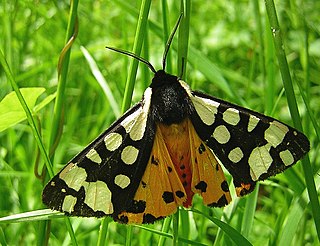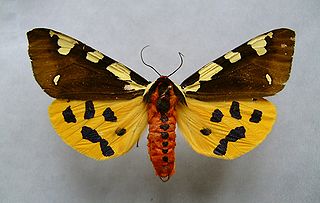
The Arctiina are a subtribe of moths in the family Erebidae.

Arctia is a genus of tiger moths in the family Erebidae. Therein, it belongs to the subtribe Arctiina in the tribe Arctiini in the subfamily Arctiinae. Species are well distributed throughout North America, Palearctic, India, and Sri Lanka.

Arctia menetriesii, the Menetries' tiger moth, is a species of tiger moth in the family Erebidae. It was first described by Eduard Friedrich Eversmann in 1846. It is found in Karelia, Oktyabrskoe, northeastern Kazakhstan, Altai Mountains, Sayan Mountains, Evenkia, Yakutia, the central Amur region, Primorsky Krai and central Sakhalin. It was believed to be extinct in Fennoscandia, but the species has been recently recorded in Finland. This species is characterized by the fact that they never come to light; such behavior is atypical in the family Arctiidae.

Arctia villica, the cream-spot tiger, is a moth of the family Erebidae. The species was first described by Carl Linnaeus in his 1758 10th edition of Systema Naturae. It is distributed from the Iberian Peninsula across western and southern Europe, Anatolia, western and northern Iran, western Siberia, southwestern Asia and North Africa.

Arctia is species of tiger moth in the family Erebidae. It was first described by Carl Linnaeus in his 1758 10th edition of Systema Naturae. It can be found in central and eastern Europe, Kazakhstan, southern Siberia, northern Mongolia, Amur Region, Primorye, Sakhalin, Kunashir, northern and northeastern China, Korea and Japan.

Arctia virginalis, the Ranchman's tiger moth, is a species of tiger moth in the family Erebidae. It was first described by Jean Baptiste Boisduval in 1852.

Arctia aulica, the brown tiger moth, is a moth of the family Erebidae. The species was first described by Carl Linnaeus in his 1758 10th edition of Systema Naturae. It is found in the temperate areas of central Europe up to the area surrounding the Amur River to the east and up to the Balkans and the Black Sea to the south.

Arctia alpina is a moth of the family Erebidae. It is found in northern Scandinavia, northern Siberia, high mountains of southern Siberia and northern Mongolia; also in Alaska and northwestern Canada.

Arctia dejeani is a species of moth in the family Erebidae first described by Jean Baptiste Godart in 1822. It is found on the Iberian Peninsula.
Arctia dido is a moth of the family Erebidae. It was described by M. Wagner in 1841. It is found in Algeria.
Arctia oberthueri is a moth of the family Erebidae. It was described by Charles Oberthür in 1890. It is found in Algeria and Tunisia.
Arctia ungemachi is a moth of the family Erebidae. It was described by Ferdinand Le Cerf in 1924. It is found in Morocco.

Arctia testudinaria, or Patton's tiger, is a moth of the family Erebidae. It was described by Geoffroy in 1785. It is found from northern Spain to southern and central France and southern Switzerland to north-eastern and southern Italy. It has also been recorded from Great Britain. The habitat consists of grasslands, slopes, forest edges, clear dry forests, cliffs and mountain slopes, maquis, garrigues and dry meadows.
Arctia ladakensis is a moth of the family Erebidae. It was described by Otto Bang-Haas in 1927. It is found in Tibet and Xinjiang in China.
Arctia tancrei is a moth of the family Erebidae. It was described by Staudinger in 1887. It is found in Kazakhstan, Uzbekistan, Tajikistan, Kyrghyzstan and China.
Arctia allardi is a moth in the family Erebidae. It was described by Charles Oberthür in 1911. It is found in China.
Arctia buddenbrocki is a moth in the family Erebidae. It was described by Hans Kotzsch in 1929. It is found in Gansu and southern Shaanxi, both in China.
Arctia cupido is a moth in the family Erebidae. It was described by Yasunori Kishida in 1995. It is found in Nepal.
Arctia hannyngtoni is a moth in the family Erebidae. It was described by George Hampson in 1910. It is found in the north-western Himalayas and Nepal.
Arctia forsteri is a moth in the family Erebidae. It was described by Franz Daniel in 1943. It is found in Sichuan, China.












